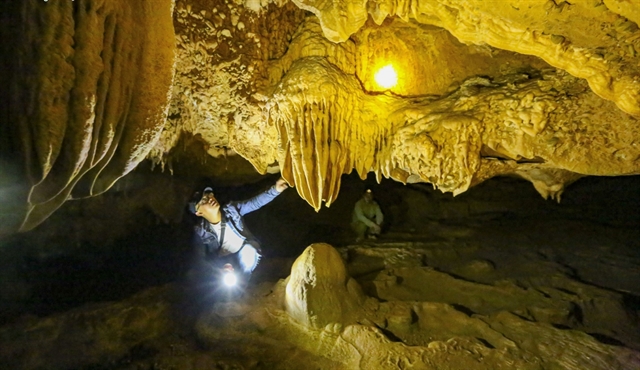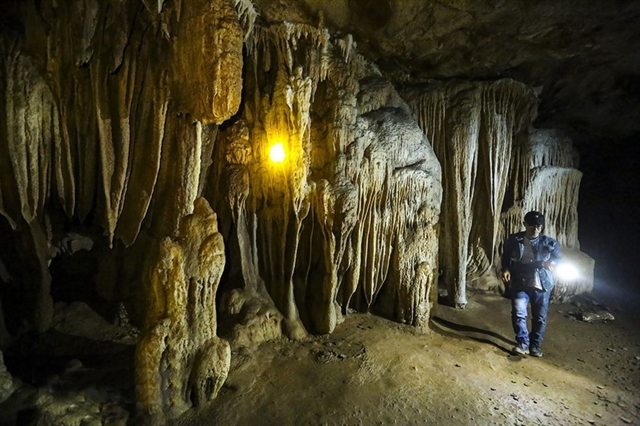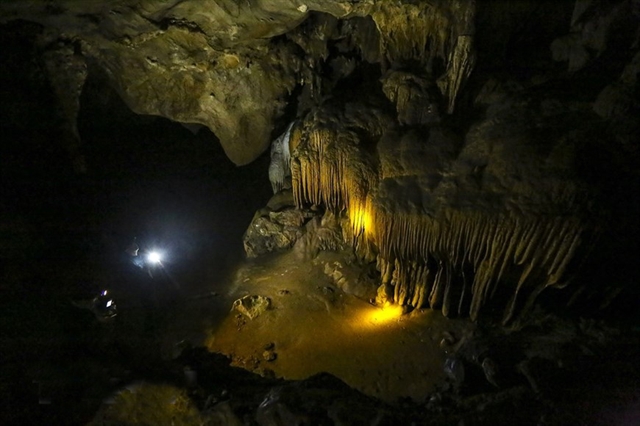With its magnificent beauty, Chua Ta Cave is an artistic masterpiece of nature and has become a popular tourism destination in Điện Biên Province.

Chua Ta cave is deep and wide. — VNA/VNS Photo Phan Tuấn Anh
Located about 40km from the centre of Điện Biên Phủ City, Chua Ta Cave is located in Na Côm Village, Hẹ Muông Commune, Điện Biên District.
The cave was discovered by local people in 2010 and five years later, it was recognised as a national relic by the Ministry of Culture, Sports and Tourism and is one of four relic sites in the district.
Located in a limestone mountain complex with rich vegetation and a fresh climate, Chua Ta Cave features diverse geology, geomorphology, topography, climate, ecology and landscape.
The cave is called "Chua Ta" because in the past there were many bees around the cave. According to the language of Mông people, "Chua" means mountain and "Ta" means bee, so “Chua Ta” means “bee mountain.”
The cave is also known as Na Côm Cave, associated with the name of the village where the relic is located.

In Chua Ta cave, there are many beautiful stalactites. — Photo truyenhinhdulich.vn
There are two routes to the cave. The first is from Điện Biên Phủ City, going through highway 279 towards Tây Trang Border Gate, through Nai Hai slope to Ka Hâu Village, turning left to reach the centre of Na Ư Commune, Điện Biên District. From here, after riding a motorbike for nearly 10km on the trail, you will come to Na Côm Village. Then after walking more than 200m, you will reach the cave entrance.
The second choice is to follow highway 279 to Pom Lót T-junction, turn left along highway 12 to the centre of Hẹ Muông Commune and then go nearly 10km to reach Na Côm Village.
These two routes are tough going and some paths can’t be reached by car because the road surface is small, with many mountain passes and slopes bending along the hillside and mountain. There are also several narrow suspension bridges on the road.
However, both routes give visitors the opportunity to admire the majestic and immense natural scenery. The cultural sub-regions of the Mông people along the way, the beauty of the terraced fields and the traditional activities of the ethnic people also offer interesting experiences.
The mouth of Chua Ta Cave is located under the forest of high trees more than 1,300m above sea level. In front of the cave entrance, there are ancient trees surrounded by interlaced vines, wild flowers and fog.
To get inside the cave, we had to lie on our side and worm through the cave entrance which is about 0.7m high.
Through the cave entrance, we saw a small gap, surrounded by steep cliffs and an open roof to form an open well. From this gap, the sun shines in from above combined with the mist to make the space fanciful and sparkling.
The cave is nearly 600m long, including two main compartments in the shape of an 'S'. The widest place in the cave is 25-30m, while the highest point of the cave arch is about 18-20m.

A visitor discover Chua Ta Cave. — VNA/VNS Photo Phan Tuấn Anh
To enter the first compartment, we followed many large and rough rocks. When we entered, the air was very cool and the natural light was no longer strong enough to see the surrounding scenery clearly, so we turned on our flashlights.
The compartment consists of many stalactites with beautiful and strange shapes such as waterfalls, images of Bodhisattvas, fairies, elephants, lizards, crocodiles, sea snails and lotus.
We were surprised and impressed by the beautiful bands of stalactites and stone curtains falling from the cave ceiling and walls.
Going deep into the cave, we passed through stones shaped like dragon eggs. Round, smooth, white, multi-sized stones were spread around the stalactites and stalagmites.

Chua Ta Cave has become a favourite tourism destination to discover and experience in Điện Biên Province. — VNA/VNS Photo Phan Tuấn Anh
The second compartment is about 10m lower than the first compartment. This makes the air here cooler. We felt small in the large space and amid the beauty of the diverse stalactites.
From here, our journey to explore and enjoy the cave was more lively thanks to the sound echoing from two small streams running along the compartment.
On the cave walls, there are white stalactites like crystalline salt or iridescent yellow stalactites. On the ceiling, stalactites precipitated in the shape of umbrellas, animals, plants and flowers with white, blue, and yellow colours interwoven.
The are many long stone ledges. In some places, there is even a "forest" of stalagmites and stalactites with different colours and shapes.
At the end of the journey, we admired the beauty of the masterpiece of terraced fields made of stone. The "fields" are filled with water, shining with sparkling light, winding like coral, one after another, as if carved by nature, harmoniously in the overall space of the cave. At the end of the cave is a small waterfall pouring water from a height of about 6m into a small stream, creating smooth sand strips.
With a magnificent beauty hidden with many mysteries, Chua Ta Cave is a masterpiece of natural art.